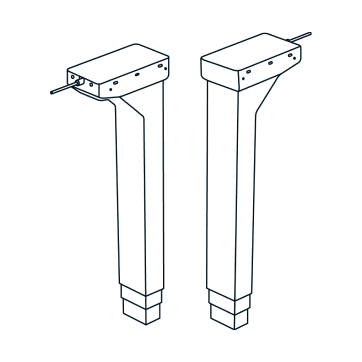WHAT IS SYNCHRONIZATION AND WHY WOULD YOU NEED IT?
What is synchronization? The concept is in the name: motion control devices being actuated in a ‘synchronized’ manner, and running at the exact same speed. The linear motion of multiple actuators are matched with each other to achieve complete synchronization. On the surface, synchronization can seem like an easy task. However, it can be entirely the opposite. Synchronization isn’t just achieved by wiring multiple actuators to the same switch, as many might presume – in an ideal world or a very simple setting, this might work. However, usually, it will result in multiple linear actuators moving at different speeds.
Even if two linear actuators of the same make and model are connected to the same power supply, a significant speed difference can occur if both are subjected to unequal loads, have experienced different wear and tear patterns, or are at different operating temperatures even, to mention a few problems. To achieve synchronized linear actuator movement, some form of motion control is a must. For an open-loop control system, the most popular synchronization option is a speed controller. A more sophisticated form of synchronized motion control is with a closed-loop system, which utilizes feedback from actuators to ascertain the individual needs of each device, making real-time adjustments. This form of synchronization is remarkably accurate, with no chance of error. There are multiple applications where linear actuator synchronization is a core requirement.
linear actuator solutions
We offer a variety of advanced controllers and various types of actuators with many customization options, ensuring our wide range has something for nearly any application. Let us assist you in finding the ideal solution to synchronize your project!



Modular lifting columns solutions
Electric lifting columns offer high performance, reliability, and safety features that can benefit a variety of applications in nearly any industry. By introducing more customization options, our release of modular lifting columns with more configurations promotes greater variety to better match your needs!




In the case of open-loop syncing, such as controlling multiple actuators with a PA-28 control box or your own programmed microcontrollers, you need to ensure that the speed controllers are capable of handling the system. There must be enough pins to accommodate the number of actuators you are using, and the code must be impeccable. When using closed-loop feedback systems, the most important factor to consider is the type of feedback encoder integrated into your synchronized actuators. In this regard, Hall effect feedback and potentiometer feedback are at the top of the list.
In Hall effect linear actuators, like the ones shown on this page, the feedback encoder records the number of revolutions the actuator’s driving motor is going through while moving. From this information, it is very easy for the controller to calculate the exact position, and hence the speed, of the actuator’s rod. The encoders of all the linear actuators are constantly sending feedback to the controller, which determines which actuator(s) is lagging or speeding up, and then adjust their respective speeds accordingly to ensure smooth, synchronized movement. When using Hall Effect actuators, it is necessary to use a compatible controller as well. You cannot use them with any ordinary controller, instead, one that is designed for this specific purpose is required. The control box must also have the desired number of channels in accordance with the number of actuators being used. Potentiometer feedback works in a similar way. As the actuator’s rod moves in and out, the potentiometer’s electrical resistance changes with it proportionately. This information is transmitted to the controller, which then performs the exact same function as explained above to synchronize actuators.
While many of our actuators can be customized to include feedback options (just check their data sheet), we also have stocked options!
Starting with our linear actuator range, we have high-performing Hall effect actuators with 12 VDC and 24 VDC variants. For example, our PA-04-HS linear actuator comes installed with a built-in Hall effect sensor that enables synchronization. Customers can also choose between 12 VDC and 24 VDC power supply options. The 12 VDC power supply linear actuators are much more common as most power supplies are of this specification. They are easier to integrate into actuation systems and pack decent performance specifications. The 24 VDC actuators need a specialized power supply, which often requires additional investment and equipment.
However, these variants are capable of delivering more power and torque, have a lower current draw, and thinner wiring requirements, which are a great compensation for the drawbacks highlighted above. No matter what your choice is, Progressive Automations makes sure that controlling multiple actuators is something worthy of your investment. For synchronization purposes, we offer multi-channel control boxes that are designed to handle feedback-based actuators, including our PA-40 and FLTCON control box series. Designed for Hall effect actuators, these controllers can work with both 12 and 24 VDC actuators. The PA-40, in fact, is a specialized synchronization solution for dual Hall Effect applications.